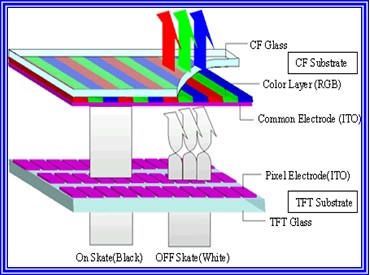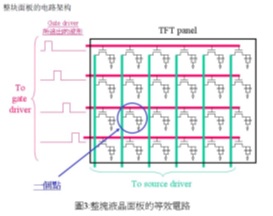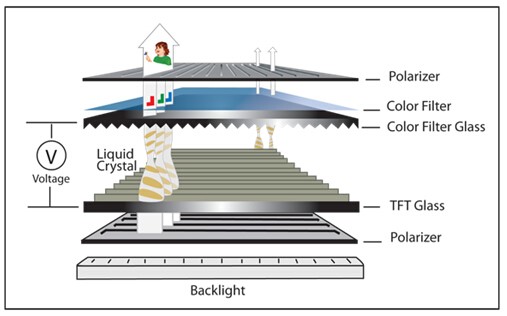CONTACT
E-mail: info@vst-display.com
TEL: 0086-13360078105
1. The working principle of TFT liquid crystal display
TFT is the abbreviation of "Thin Film Transistor", which generally refers to thin film liquid crystal displays, but actually refers to thin film transistors (matrix)-which can "actively" control individual pixels on the screen. This is the origin of the so-called active matrix TFT (active matrix TFT).
So how exactly is the image produced? The basic principle is very simple: the display screen is composed of many pixels that can get light of any color through, and the purpose can be achieved by controlling each pixel to display the corresponding color. In TFT LCD, backlight technology is generally used. In order to accurately control the color and brightness of each pixel, it is necessary to install a shutter-like switch after each pixel. When the "blinds" are opened, light can pass through. When the shutters are closed, light cannot pass through. Of course, technically, it is not as simple as the one just mentioned. The structure of the liquid crystal molecules is unchanged, but when the power is applied, the liquid crystal molecules rotate, just like the shutters from closed to open. If the shutters are completely closed, it is completely black, and if the shutters are fully opened, it is completely white, and the shutters are closed to completeness. Open and divide into 64/256 parts, that is, 64/256 different brightness can be realized, and with three different color filter films, 262K/16.7M colors can be realized.
TFT pixel structure: Everyone knows the three primary colors, so each pixel on the display screen needs three similar basic components described above to control the three colors of red, green, and blue respectively. color filters are divided into three types: red, green, and blue according to colors, which are arranged on the glass substrate to form a group (dot pitch) corresponding to a pixel. Each monochromatic filter is called It is a sub-pixel. In other words, if a TFT display supports a maximum resolution of 1280 × 1024, then at least 1280 × 3 × 1024 sub-pixels and transistors are required.

In an active matrix LCD, each pixel has a TFT whose gate is connected to the horizontal scan line, the drain is connected to the vertical data line, and the source is connected to the liquid crystal electrode; The display starts one horizontal scan line at a time, turns on the TFT, and the vertical data line sends the corresponding display signal to charge the liquid crystal electrode to an appropriate voltage; Then turn off the TFT, until the next time the signal is rewritten, the corresponding charge remains on the capacitor, and at the same time the next horizontal scan line is started, and the corresponding display signal is sent; Write the display signal data of the entire screen in sequence, and then return to the first line to rewrite the signal. Generally, the frequency of this repetition is 60~70Hz.

For each pixel, the voltage across the liquid crystal has a certain relationship with the transmittance, and the transmittance of the same voltage is exactly the same. Therefore, as long as the voltage written in can be controlled, the desired picture can be displayed.
2. TFT display module structure.
The TFT display module is composed of TFT CELL, driver IC, FPC connection circuit, backlight, PCB board circuit and other components.
TFT CELL is composed of bottom polarizer, TFT glass substrate, liquid crystal, CF glass substrate, surface polarizer and other components.
The driver IC provides the signals and voltages required by the driver during the entire scanning process;
FPC, PCB, etc. provide related auxiliary circuits for the driver IC, communicate with the MCU of the customer's motherboard, and receive display signals.

3.TFT panel type
Common LCD panel types in TFT-LCD products include traditional TN panels, wide viewing angle IPS and MVA panels. TN type panels are usually used in NW (normally white) TFT-LCD technology, while IPS and MVA type panels are usually used in NB (normally black) TFT-LCD wide viewing angle technology.
CONTACT
E-mail: info@vst-display.com
TEL: 0086-13360078105